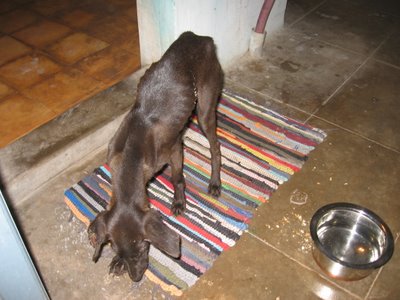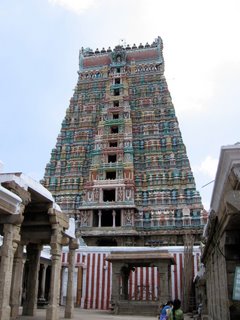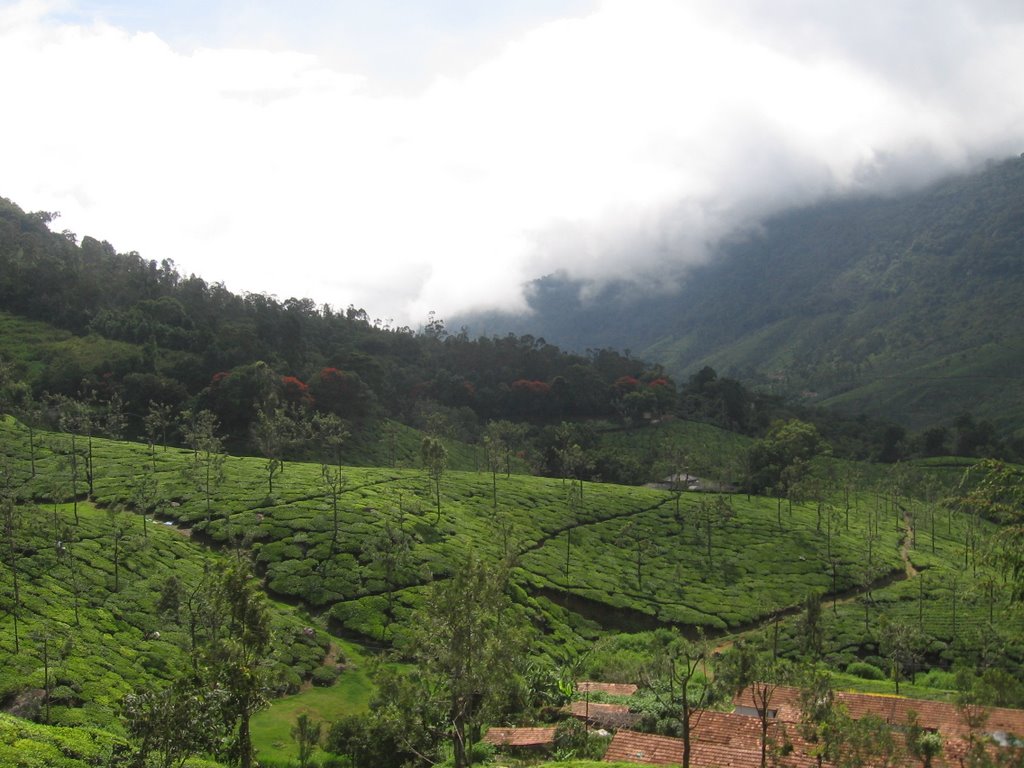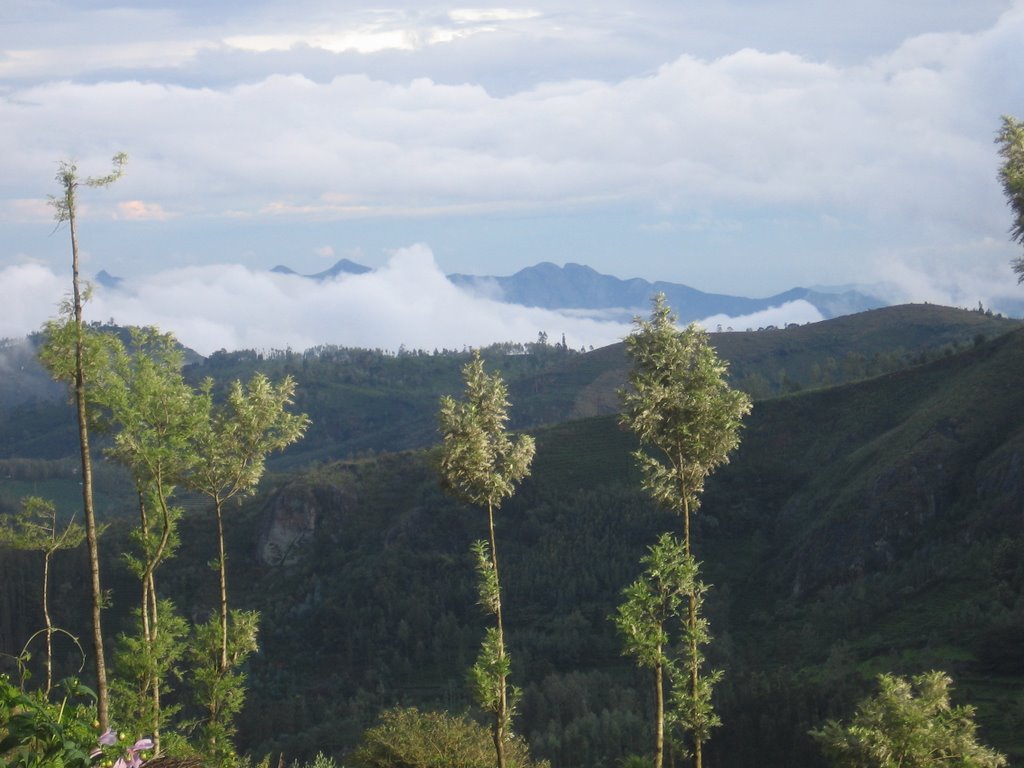 This is Pumpkin.
This is Pumpkin.I first saw Pumpkin lying in a pile of garbage by the side of the road. I was not surprised. She was shivering, and her nose was inside a plastic bag. Every rib and vertebrae was visible. She was coated in filth. Once I realized the thing I was looking at in the pile of garbage was alive, and was clearly suffering from starvation, I couldn't do nothing. I have walked past suffering (in humans and animals) too many times here in India, and for some reason I could not do it one more time.
I wanted to do something, but I still wasn't sure what would be best. What can you feed a starving and suffering animal that won't harm it further? I called another American friend who had previously adopted a puppy off the street here in Madurai. The answer was biscuits and milk or water. I bought biscuits and water and went over to the dog. I didn't yet know what else I would or could do, but doing something to help felt right.
After she started eating the biscuits and water I took her out of the garbage pile. After she ate the entire package of biscuits and drank some water, I decided to take her home. I didn't know if I could keep her, but she had such enthusiasm for the food, and it seemed like she deserved to be given a chance at living, rather than die in a pile of garbage.
As I was walking home with her in my arms, it dawned on me that her shivering was not really shivering at all, but a muscle twitch that was persistent. It occurred to me that something might be wrong with her other than starvation. I called my American friend again and asked if she knew of a Veterinarian. I went to the recommended location, and found the Vet operating out of an office about 4 feet by 5 feet. I was skeptical, but it is generally true in India that people care less about animals and have fewer pets than Americans. So it was understandable. I paid the Vet 400 rupees, for which he gave her an antibiotic shot, and two vaccines, one for Rabies and one for a variety of other communicable diseases. But he also diagnosed her muscle twitches as Distemper, a viral infection, which I was not at all familiar with. He said she had a chance at recovery, although he did warn me that it is sometimes fatal. I took her home, not knowing what else to do, but try to feed her sufficiently to help her get over the virus.
I bathed her and discovered that she was barely strong enough to stand. She had difficulty it seemed, mostly because her muscles had wasted away to such an extent that they just couldn't support her for more than a few seconds. The other problem was the twitch. But she kept trying, and I deemed her "a fighter".
"She wants to live." I told my friends who questioned the decision to adopt a sick stray off the street. "She deserves the chance to live."
I bought the antibiotic tablets the Vet prescribed and Pedigree puppy chow. After the first night, in which a puddle of pee and a puddle of puppy diarrhea appeared on my floor, I decided to keep her mostly on the balcony, and outdoor space that would be easier to clean. Since she could barely get up to go bathroom off the mat she was laying on, this seemed best. I also had come to realize that I probably wouldn't be able to keep her, or take her to the US, and I should not allow either myself or her to develop too much of an attachment.
I found her on Tuesday afternoon. Halloween, and it was then that I decided to call her Pumpkin. Wednesday she seemed better, stronger, and although sad to be left alone a lot of the time. Thursday seemed even better. She was still weak, but she was eating heartily, including the scrambled egg I cooked for her.
My landlady complained that she whined a lot, but there was not much I could do. On Thursday afternoon after I went out, and found her lying in an awkward pile with her neck bent backwards. She had gotten up to go to the bathroom, and fallen down on her way back to the mat. She had been unable to get up.
Friday was worse. I fed her another scrambled egg and puppy chow in the morning, and when I found her Friday afternoon, she had vomited all the food I had given her and was lying in the puddle of her own diarrhea and had been unable to get up and move. It occurred to me then that she might not make it, and that the best thing to do might be to have her euthanized. I cried at the thought of it, but still I started thinking that might be the end result.
By Saturday morning she was having seizures, and had been unable to get up off her mat to go to the bathroom. She was having trouble breathing but was still holding on. She had vomited even the water that I gave her.
I knew it was time to let her go. She was twitching, seizing, and whining as if in pain. I decided it was time to take her to the government veterinary hospital to have her euthanized.
When we arrive at a quarter to seven in the morning, the auto driver assured me they would arrive at seven. But they didn't open until 8 and the Vet didn't come until 8:30. When he did arrive, and finally saw me and the puppy he told me they don't do that there. He claimed there was some kind of government law or regulation against it. I sort of pleaded with him, saying it was the humane thing to do. And he said something vague to the effect of "Maybe we can do something to ease her pain." I looked at him completely blankly, and he walked away.
Finally I went to find him, to ask if they couldn't or wouldn't euthanize her here, where could I go? He said, "No, No. I'll send my deputy." I looked at him blankly again, tears running down my face.
What is a deputy for a Veterinarian? In what way is he a deputy? What does that mean? So the deputy, came and told me I had to write a letter. It was all very vague, but he brought me a piece of paper and I started writing. Then the Vet came out and looked at the letter and told me it was all wrong. I had to start over. I had to address it a certain way, and give the specifics of the dog. Her name, age, sex, color, breed, etc. I looked at the Vet when he said breed, like, what do you mean "breed"? Look at her. She's a street dog. And he said: "You can put down 'local breed'." So I rewrote the letter and gave it to the Vet. He took it and waved me off in a vague direction. "Take her over there." I wandered in that direction, dog in my arms, sobbing. Finally someone pointed me to the "operating room" and had me lay her on the table. Then they told me to leave the room. When I left her, she started crying loudly and I started crying even harder.
The auto rickshaw driver was telling me "It's ok madam, don't worry." And one of the women working there, was saying to me in Tamil, "Don't cry, don't cry." And then, finally, practically shouting it, "STOP CRYING!" I tried to stop but couldn't really do it. I realized it was culturally inappropriate to display so much emotion over a dog. But there was nothing I was going to do about that.
The Vet called me over again to inform me that they would not be able to do anything with the body, that I would have to take it with me. I said ok, I don't really know where to take it, or what to do, but I will take it and I will figure something out. I said this because it seemed to be a condition of their doing this thing for me. The auto driver was there, and the Vet explained it to him too, and he said he could find someone. So then the Vet asked if I was done with the dog.
I said no. I hadn't really said goodbye. So I went back inside, and said goodbye to her. I kissed her face, and said I was sorry, and I hope she gets another chance at another and a better life. I didn't know that I believe in reincarnation, but apparently I do. She got such a bad deal in life this time, I just kept thinking I hope it gets better than this. I looked her in the eyes, and I felt that she understood. And then I left again. They forbade me to be in the room.
A few minutes later they came out and told me it was over. I went in and saw her, both sad that she was gone, and happy that she was free of the shell in which she had suffered. Her body was still for the first time. The muscle twitching that had been constantly plaguing her was gone. I collected her body in the shawl in which I had been carrying her, and lay her on the floor of the auto.
I cried the whole way home, despite the auto drivers pleas of "Don't worry, madam. It will be alright, madam."
In the neighborhood near my house we pulled over to the side of the road next to some people sitting there. The auto driver called a man over and explained that he should dispose of the body. The man made a face, but said yes. Then the drive turned to me and said, "Give him 100 rupees." So I gave him 100 rupees, and he took the body. The driver assured me he would do a good job burying it.
I got home, and my landlady asked what happened. I couldn't really explain it to her, but she gave me coffee, and asked in Tamil if I "felt". "Feel pannriyaa?", she asked.
"Yes," I said, "I feel."


 After Venice, we took the train to Florence (Firenze), and from Firenze to Siena for a day. From Firenze we returned to Bologna where we first arrived, and flew home. The best parts of the trip involved a lot of wine and/or sangria, and are thus a bit fuzzy in my memory. The little local bar on the corner by the Hostel outside Bologna was fantastic. They were truly the local flavor. The glasses of wine also only cost 1 euro, and were filled to the brim.
After Venice, we took the train to Florence (Firenze), and from Firenze to Siena for a day. From Firenze we returned to Bologna where we first arrived, and flew home. The best parts of the trip involved a lot of wine and/or sangria, and are thus a bit fuzzy in my memory. The little local bar on the corner by the Hostel outside Bologna was fantastic. They were truly the local flavor. The glasses of wine also only cost 1 euro, and were filled to the brim.




































